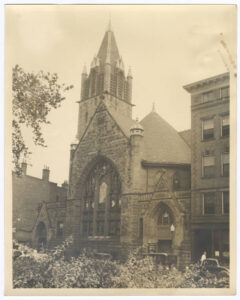December 8, 2021, a group of forty Lutherans gathered in Washington park to commemorate the 180th anniversary of the first worship service of First English Evangelical Lutheran Church in 1841. The commemoration was not held in the historic 1895 building located at 1208 Race Street because the 130ft tall bell tower structure has been deemed a danger to the community, an issue First Lutheran is working actively to address. The first group of only eight people in 1841 were without a building as well and were uncertain about what their future together might look like.
Congregational histories are often told, and romanticized, by “historians” of the congregation who are called upon to write something for an anniversary booklet. These booklets are distributed to members and contain pictures. This makes them likely to survive the passage of time in a special box or drawer in someone’s home or a congregational archive. The people who “lived” the history are long gone when these commemorative booklets are dusted off generations later and read by nostalgic eyes.
First Lutheran is often lifted, appropriately so, as a progressive faith community. Reverend Abram Reck visited Cincinnati in September 1841 and witnessed firsthand the devastation brought about by recent riots that were rooted in the efforts of the anti-abolitionists to put an end to the work of abolitionists. Rev. Reck committed to starting a congregation that could support the work of abolitionists. What is not reported is that it was not until 1953, 112 years later, before the first African American member was welcomed.

January 12, 1870, was a significant day in First’s history. It was on that day that the congregation voted to amend its constitution making women full voting members. Clara Baur, founder of Cincinnati Conservatory of Music, was a member at the time. Her name shows up in the archives as a Sunday School teacher, children’s ministry volunteer and financial supporter. We can be confident that when the 1895 church was constructed, her expertise in music earned her a seat at the table with the architects and engineers during the design process. The acoustics of the progressively designed structure affirms that. The story of how women like Clara shaped the First Lutheran community are passed down, but what remains missing, after 152 years, First has yet to Call an ordained female pastor.
First’s progressive nature has helped it to successfully navigate several contextual shifts. One example occurred on March 3, 1950, when the newly arrived Reverend Miller boldly stated that the congregation would not leave OTR, like so many others, but would rather find a way to serve the new residents of the neighborhood, even if they were not Lutheran. The story that is not told, and perhaps should be since it increases the conviction it took to make the statement, is the story of Pastor Lutton who had just left. Pastor Lutton served First through Depression and War. He watched the congregation decline to the point of closure. The Church Council Minutes tell the story of his dedication. His departure came only when his physician told him he needed to do so or else it would kill him. He moved to Arizona where a few short months later he died.
Faith communities, whatever the tradition, are a mixture of sorrows and joys and are at their best when they faithfully name and claim both.
February 20, marked the 180th anniversary of First Lutheran’s incorporation, and more importantly its continued purpose of sharing the love of God. We look forward to sharing this good work with all the faith communities in Cincinnati.
Pastor Brian Ferguson




